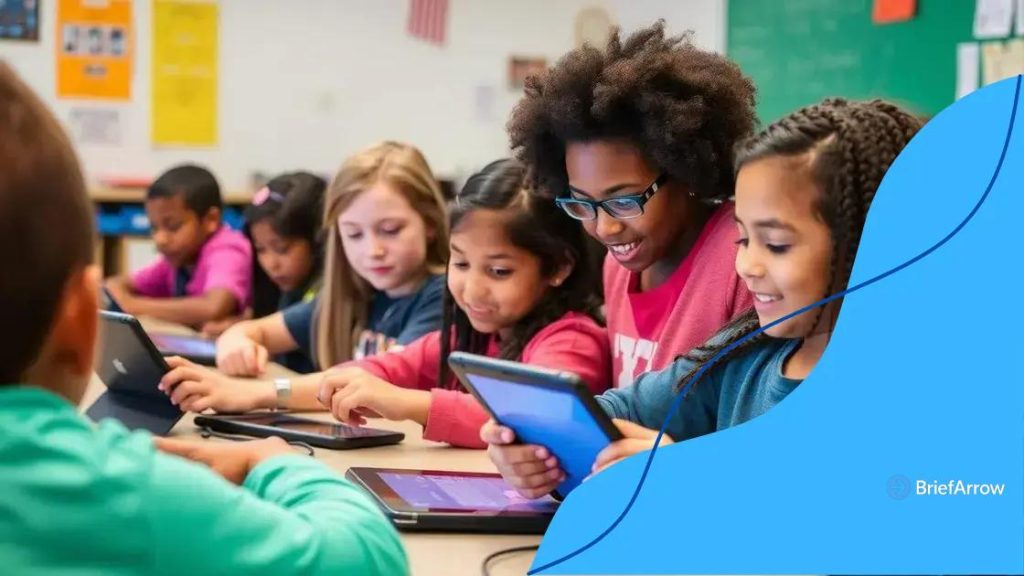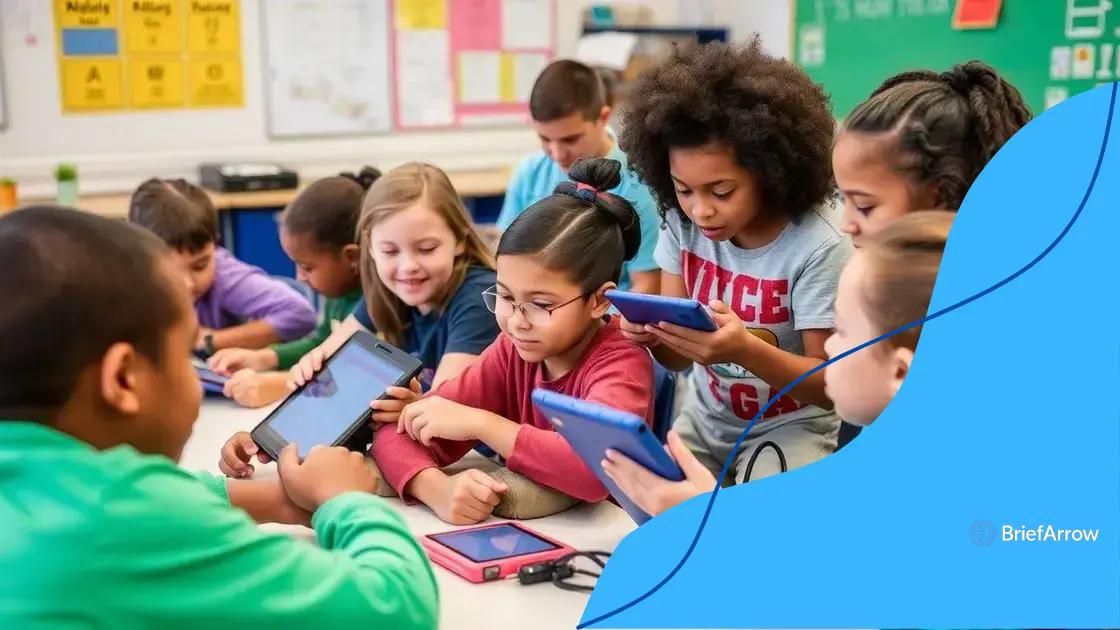Assistive technology for students with disabilities explained

Anúncios
Assistive technology for students with disabilities enhances learning by providing tailored tools that empower communication, boost independence, and improve academic performance in inclusive educational environments.
Assistive technology for students with disabilities plays a crucial role in enhancing learning experiences. Have you ever considered how these tools can change a student’s daily life? Let’s dive into the world of assistive technology and explore its impact.
Anúncios
Understanding assistive technology
Understanding assistive technology is essential for recognizing how it can help improve the lives of students with disabilities. These technologies are designed to support learning and make educational environments more accessible.
What is Assistive Technology?
Assistive technology refers to tools and devices that assist individuals in performing tasks that they might find challenging. This technology can range from simple tools, like pencil grips, to advanced devices, such as speech recognition software.
Types of Assistive Technology Tools
There are various types of assistive technology tools available today:
Anúncios
- Communication devices, like speech-generating software
- Mobility aids, including wheelchairs and adjustable desks
- Learning tools, such as audio books and text-to-speech programs
- Adaptive hardware, like switch devices for easier use
Each type of assistive technology serves a particular purpose, tailoring education to meet individual needs. For instance, communication devices enable students who have difficulty speaking to express themselves more effectively.
In addition to tools, assistive technology encompasses services, such as evaluations and training, helping students learn how to use these technologies successfully. This holistic approach ensures that students receive the support they need.
Benefits of Assistive Technology
The benefits of assistive technology are significant. They can help improve academic performance and enhance self-esteem. Students often find that these tools make learning more engaging and enjoyable, leading to better outcomes. Moreover, assistive technology fosters independence by allowing students to complete tasks on their own.
With the right tools, skills, and support, students with disabilities can thrive in educational settings. Learning is not just about books and tests; it’s about finding the right methods to connect with knowledge.
Types of assistive technology tools
There are many different assistive technology tools available to support students with disabilities. Understanding these tools can help educators and parents make informed decisions that enhance learning experiences.
Types of Assistive Technology Tools
Various tools serve specific purposes and offer unique benefits. These technologies can generally be categorized into several types:
- Communication Devices: Tools like speech-generating devices help students express themselves.
- Mobility Aids: Equipment such as wheelchairs and walkers ensure that students can navigate their environments comfortably.
- Learning Aids: Items such as audio books, graphic organizers, and apps that facilitate various learning styles.
- Adaptive Software: Programs that modify a computer’s interface, making it easier for students to interact with technological tools.
Each of these tools empowers students, catering to their individual needs. For instance, communication devices are invaluable for those who may struggle with verbal communication, while adaptive software allows students to engage with digital content more effectively.
Tools like text-to-speech applications also make it easier for students with reading difficulties to absorb information. By listening to text, they can follow along and improve their comprehension.
Choosing the Right Tools
Selecting the appropriate assistive technology requires careful consideration of each student’s unique challenges. For example, students with visual impairments might benefit greatly from screen readers, while those with physical disabilities may require devices that assist with mobility.
Collaboration among educators, parents, and specialists is essential to identify which tools best suit individual needs. Regular assessments can help evaluate ongoing effectiveness and indicate when adjustments are needed.
How assistive technology benefits students

Understanding how assistive technology benefits students is crucial for creating inclusive educational environments. These technologies not only provide support but also enhance learning experiences for students with disabilities.
Enhancing Learning Opportunities
Assistive technology opens up a world of possibilities. For example, students who may struggle with traditional learning methods can find new ways to engage with content. Tools like audio books and interactive apps provide diverse learning modalities.
Boosting Confidence and Independence
With the right assistive technology, students gain confidence in their abilities. When students use tools that help them communicate or learn at their own pace, they become more independent. This sense of autonomy can lead to greater participation in classroom activities.
- Increased ability to express themselves verbally or through writing.
- Enhanced problem-solving skills through adaptive learning tools.
- Opportunities for collaboration with peers using shared technologies.
By removing barriers, assistive technology fosters an environment where all students can thrive. Parents and educators often notice significant improvements in engagement and enthusiasm for learning.
Supporting Individual Needs
Every student has unique needs. Assistive technology is versatile and can be tailored to fit those needs. For instance, a student with dyslexia might benefit from text-to-speech software, while another student with physical disabilities may use touch screens or special input devices.
This adaptability ensures that all students are provided with the tools necessary for their success. As students grow, their needs might change, and so can the technologies they use.
Implementing assistive technology in schools
Implementing assistive technology in schools is a vital step in creating inclusive learning environments. When done correctly, it can make education more accessible and engaging for all students.
Assessing Individual Needs
The first step in implementing assistive technology is assessing the needs of each student. Teachers and specialists should work together to identify the challenges that students face. This process involves understanding each student’s strengths and areas where they need support.
Choosing the Right Tools
Once needs are identified, selecting the appropriate tools becomes crucial. Various types of assistive technology can be employed:
- Text-to-speech software: Helps students with reading difficulties.
- Speech recognition programs: Assist students who have difficulties writing.
- Adapted keyboards and mice: Make computer use easier for students with physical disabilities.
- Visual aids: Such as tablets and interactive displays, enhance engagement.
Choosing the right tools often involves trial and feedback. Students and educators should provide input to ensure the tools are effective and beneficial.
Training and Support
Both teachers and students need proper training to maximize the potential of assistive technology. Professional development workshops can help educators understand how to integrate these tools into their curriculum. Meanwhile, students should receive hands-on training to ensure they are comfortable using the technology.
Regular support and adjustments may also be necessary. As students grow and their needs change, the tools and strategies should evolve alongside them.
Real-life success stories of assistive technology
Real-life success stories of assistive technology demonstrate its profound impact on students with disabilities. These stories not only inspire but also showcase how technology can transform learning experiences.
Empowering Individual Students
Many students have thrived with the help of assistive technology. For instance, one student named Emily used a speech-generating device to communicate effectively for the first time. This technology allowed her to express her thoughts clearly, leading to improved social interactions and friendships.
Improving Academic Performance
Another example is Alex, a student with dyslexia. He struggled with reading until he discovered text-to-speech software. With this tool, he could follow along with books while listening. As a result, his grades improved significantly, and he started participating more in class discussions.
- Enhanced communication: Tools like communication boards and apps help students express themselves.
- Boosted confidence: Many students feel more capable when using assistive technology.
- Increased independence: Technology empowers students to complete tasks on their own.
Teachers who have integrated assistive technology into their classrooms also report positive changes. They notice that students are more engaged and collaborative. These success stories are important because they highlight the potential of technology to level the playing field.
Creating Inclusive Opportunities
Success stories of assistive technology are not limited to individual achievements. Schools are embracing inclusive practices by providing access to various tools and resources. Programs designed to support students with disabilities demonstrate that inclusion benefits everyone.
The stories of Emily and Alex show the vital role that assistive technology plays in helping students reach their full potential. Their journeys encourage schools to continue adopting these invaluable tools, paving the way for future success.
FAQ – Frequently Asked Questions about Assistive Technology
What is assistive technology?
Assistive technology includes tools and devices that help individuals with disabilities perform tasks and enhance their learning experiences.
How can assistive technology benefit students?
Assistive technology empowers students, boosts their confidence, improves academic performance, and promotes independence in learning.
What types of assistive technology tools are available?
Common tools include communication devices, text-to-speech software, adaptive hardware, and learning aids tailored to individual needs.
How can schools effectively implement assistive technology?
Schools should assess individual student needs, choose appropriate tools, provide training for both teachers and students, and offer ongoing support.